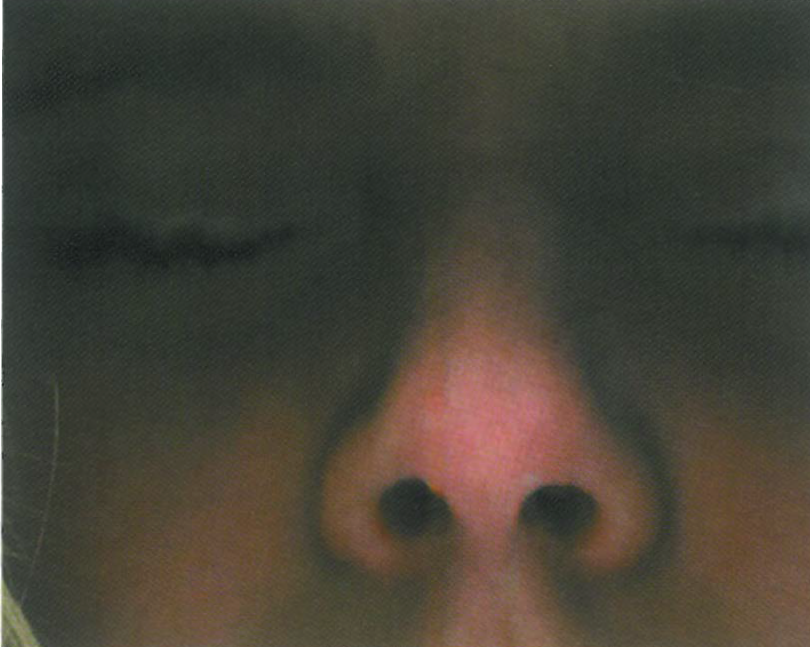
Morphologies is an exhibition that disturbs the viewer. Each piece has its own poignant message about contemporary society and although some approached this with humour the underlying theme is still powerful and unsettling. As the title suggests, the works in this exhibition explore shape-changing, mutation and the redefinition of form and structure in relation to contemporary issues. The exhibition is a potent mix of the playful and the deadly serious.
With two exceptions the works in the exhibition are interactive – DVD-rom, CD-rom and video projections. The thematic content of these works is based on their interactivity and therefore by participating the viewer becomes complicit with the work. Artspace showed work by Agnes Hegedüs, Ian Howard, Jeffrey Shaw, SKAN and Peter Weibel. Ivan Dougherty Gallery housed the work of Dennis Del Favero, Susan Norrie and Jeffrey Shaw. As a curator at Ivan Dougherty Gallery I worked closely on the installation of the three works exhibited there and as such I have a view of the exhibition that starts with technical details: size, cost, capacity, sound, light and so on. As anyone who installs exhibitions will know, it is only after all these details are sorted out that you are able to appreciate the work for its content.
Playful on the surface, Ian Howard's interactive DVD-ROM SweetStalking is a game where the viewer can choose a sequence of images and when five have been selected they play one by one as mini stories. Together they create a narrative about seeking meaning in relationship and daily life. This is occasionally interrupted by a random dice throw suggesting the lack of choice we have in the hand we are dealt each day. The result is a colourful montage of images both moving and still that explore the unlimited interpretations of the meaning of relationship.

Making meaning out of life and relationships is a primary contemporary concern and one way in which we do this is to surround ourselves with things and people, that are important to us. Agnes Hegedüs has created two interactive DVD-roms about objects and the meaning they have for the owner. Things Spoken presents a catalogued collection of objects owned by the artist. The information about each object, including its importance to the artist, is available to the viewer as they navigate through the various options. It is possible to sort the objects by criteria such as size, colour, weight and function. Similarly, Their Things Spoken uses objects belonging to other people who tell the story of why the object is important to them – how they got it and what it means to them. The viewer is able to scroll through the images and select the story/object they want to hear/see.
Perhaps more important than objects to give our lives meaning is place. Place and identity feature strongly in Jeffrey Shaw's interactive DVD-rom Place-Urbanity. This work consists of a number of panoramic cityscapes of Melbourne each representing a different ethnic community. By clicking on a map of the city the viewer is taken to a different panorama. In each panoramic view there is a comedian hanging upside down telling a joke or story. This work is highly entertaining while addressing crucial issues of today's multi-cultural, yet hardly inclusive, society.
Another major concern today is our environment and the continuing contamination that is taking place around the globe. Susan Norrie's Defile is an interactive DVD-rom that explores the possibilities of the interactive process through a montage of imagery and sound – all of which relate to recent environmental disasters. The viewer participates by using a mouse to move through a series of images/video segments. There is a relationship between the anxiety over the world's condition and the anxiety the viewer experiences navigating through such a work. There are several different sound/image sequences all of which I found difficult to view. The least disturbing of the soundtracks is reminiscent of airport music; however it was preferable to the ripping of tape or the crying baby.
The most powerful piece in the exhibition is Dennis Del Favero's multi-phase three-channel video installation Angelo Nero, and it was also the most difficult for me to view. Interestingly, it is not interactive – the viewer has no control or ability to influence the work – you either stay to watch or leave. Three massive screens and penetrating sound fill the space. Images from CNN news, a masked naked man and a boy aiming a gun at the audience flash across the screens. The images are uncomfortably familiar and sometimes excruciating to watch and yet, the viewer is compelled to stop and watch, even when just passing through.
The exhibition Morphologies deals with a multitude of issues and concerns. It stretches the boundaries of the interactive process and explores various aspects of new media and technology. Many of the works address vital contemporary issues – on a personal level they explore relationship, identity and place, while on a global level they explore environmental disasters, war and violence.
What stays is a line from Dennis Del Favero's soundtrack. 'You said everything would be all right and the scientists knew what they were doing but they don't dad they don't, nobody does'. This not only speaks of the confusion and distress that is occurring around the world but also more privately it reflects that moment when the innocence of childhood is disrupted by the realisation that our parents do not have all the answers, nobody does.












